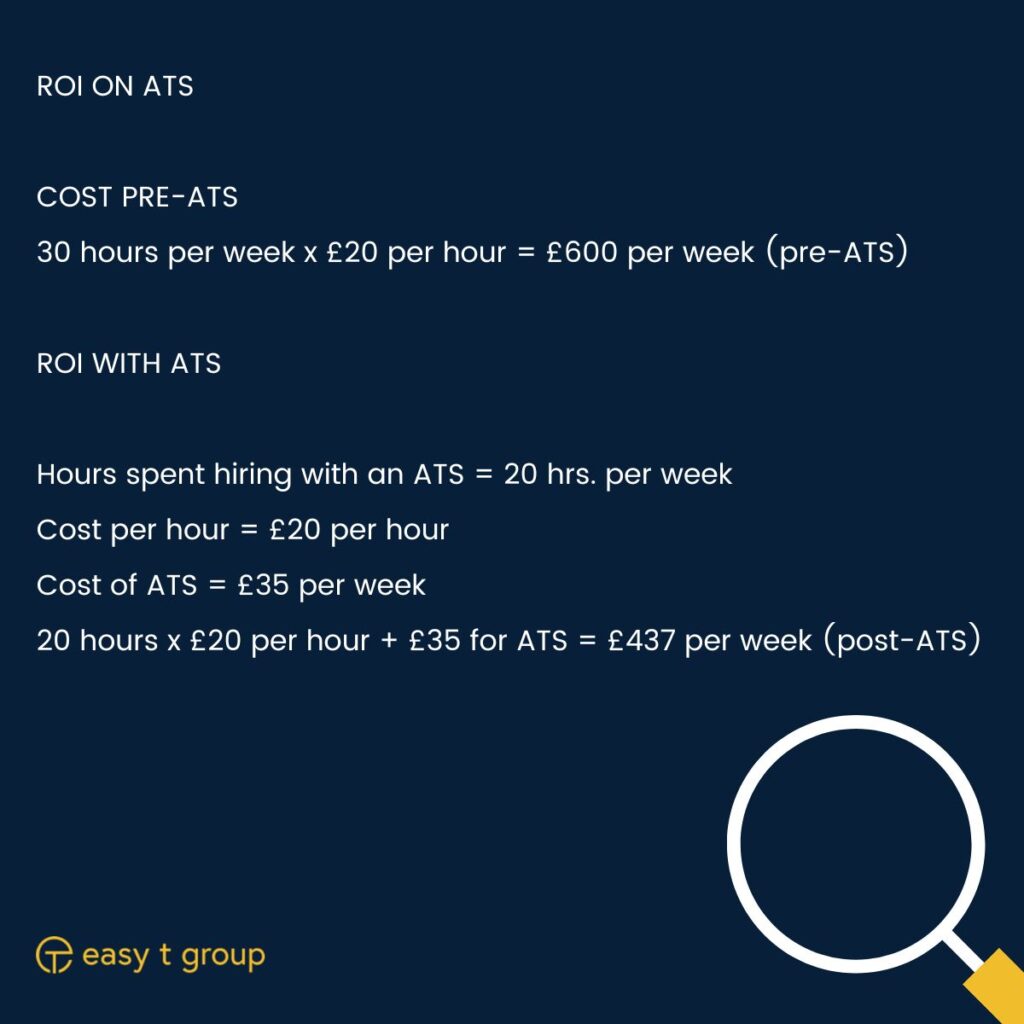How To Calculate the ROI of Recruitment Software

Love them or hate them, recruitment metrics are invaluable to any business. This data gives you personalised insights into your business success and whether your recruitment software provides a good ROI.
If you’re new to recruitment software ROI, you might not know which analytics are most important for this calculation. Learning which data provides a glimpse into your recruitment ROI is simple with an expert-approved list by your side.
Keep reading to find out the metrics you need to calculate the ROI of your recruitment software and how to get started. Let’s dive straight in.
What Does ROI Mean in Recruitment?
Before we dive into the top metrics you need to know, we’ll quickly recap what ROI means in the recruitment world.
ROI (return on investment) is the ratio of money invested compared to the money or value returned to the business. In recruitment, the ROI is the value your recruited staff bring to the company and how much time and money the recruitment software tool saves you.
If your recruitment software tool makes your business more effective and profitable through streamlined hiring processes and talented candidates, it’s a good ROI. These days, you can find recruitment software for all sectors and niches.
How to Calculate the ROI of Recruitment Software: 7 Important Metrics You Need

So, how do you calculate the ROI of your recruitment software tool? Keep an eye on these metrics to see whether your recruitment software tool is helping or hindering your hiring funnel.
1. Cost Per Hire
The first metric to examine is the cost per hire. This reflects the total costs of recruiting a new hire, including advertising, screening, interviewing, and onboarding the client. If it’s involved in the hiring process, it’s included in the cost!
This metric can reveal the efficiency and expense of the recruitment process. Without recruitment software, it’s easy to accidentally spend on marketing, add-on features, subscription fees, and more. Using a streamlined tool will quickly cut these extra costs.
2. Candidate Experience
Another key metric is candidate experience. Are your applicants greeted with an easy-to-understand hiring process? Or are your potential hires jumping through confusing hoops to join your team?
A poor hiring process can harm your brand reputation and put off talented candidates. Using recruitment software with a streamlined process and strong communication will ensure a smooth experience and make tracking applications much easier — alongside other benefits.
3. Application Completion Rate
Your application completion rate is the number of candidates who start and submit an application.
It’s normal to have a few drop-offs, but if you’re receiving few completed applications or have noticed a negative trend, it might be a sign your questions aren’t engaging or are too lengthy.
4. Quality of Hire
Quality of hire is a subjective metric, but it’s still important. In fact, for most companies, quality of hire is the most vital recruitment metric.
Examining the quality of your past hires is helpful for the future of your recruitment process. For example, you can look at what went well in a successful hire and replicate the factors for future success. Likewise, you can reflect on what didn’t go so well to avoid repeating mistakes.
You can measure the quality of your hires via:
Client satisfaction
Performance review scores
Retention rates
5. Offer Acceptance Rate
Believe it or not, applicants turn down job offers frequently, usually due to a negative experience during the interview stage. Your offer acceptance rate is the number of accepted offers divided by the number of offers sent. This metric shows how successful your business is in the hiring process.
6. Recruiter Productivity
Valuable recruitment software has many benefits including supporting your hiring team by taking the time-consuming admin tasks off their to-do list, allowing them to focus on their important tasks.
You can see how effective your software tool is by monitoring the number of applications processed per day, number of interviews, accepted offers, and overall time spent on recruitment tasks.
Remember, software is here to make life easier — not to add more time to the hiring journey.
7. Time To Fill & Time To Hire
How long does your hiring process take?
The time to fill shows the time between HR approving a job requisition and a job acceptance. Time to hire measures the candidate’s individual journey from the date of their application to the date of acceptance.
Job vacancies cost companies money and productivity. So, streamlining your hiring process with recruitment software and closing the gap between these times will improve your recruitment ROI.
The ROI of Recruitment Software – The Takeaway
Whether you already use a recruitment tool or are considering adding software into the mix, taking a moment to consider the ROI of recruitment software is critical for your company’s growth. This way, you can track your results and work towards a more optimised recruitment experience.
About Easy Tech
Easy Tech provides bespoke end-to-end temporary recruitment software to help you streamline your hiring process. We work with a variety of different industries providing recruitment software for nursing agencies, teacher recruitment, manufacturing industry, hospitality & catering, construction, oil & gas and the rail industry. So whatever industry your recruitment agency specialises in we are definitely able to help you with the perfect software for you.